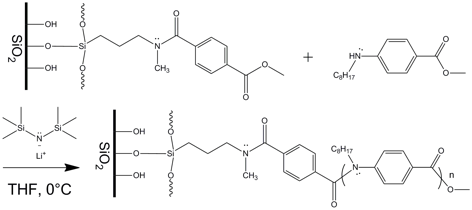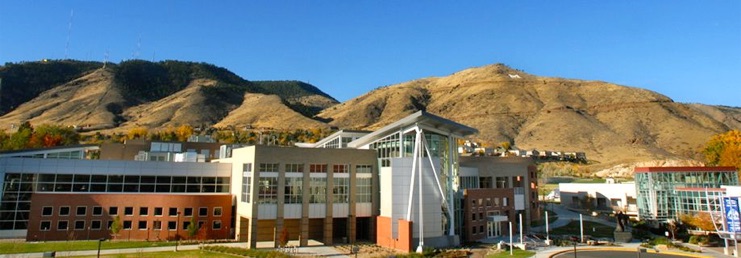Research Projects
Each year, the list of projects offered for that year will be sent to the selected participants approximately one month before the start of the REU program. However, the following provides some example projects that have been offered to students in the past:
Biodegradable Nanofiber Scaffolds for Bone Tissue Engineering (Boyes)
Scaffolds play a pivotal role in the process of regenerating tissues in 3D. Recently there has been increasing interest in the use of scaffolds for bone tissue engineering to improve clinical therapy for patients suffering serious fractures or defects. Biodegradable synthetic polymers are the most widely used scaffolding materials. However, synthetic polymers lack the biological cues found in the natural extracellular matrix. In this project, block copolymers providing biodegradability, biocompatibility, and functional groups for attachment of peptides, growth factors, and drugs will be prepared.
These block copolymers will be formed into nanofibrous scaffolds using electrospinning or thermally-induced phase separation techniques. Finally, the mechanical properties of the nanofibrous scaffolds will be investigated. To achieve this goal, two undergraduate students, one from chemistry and one from chemical engineering, will work together.
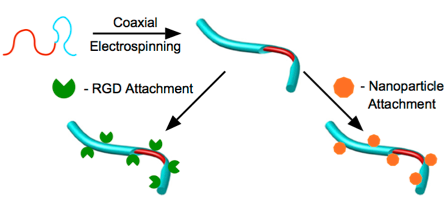
The chemistry student will focus on polymer synthesis, while the chemical engineering student will focus on scaffold formation and mechanical properties. By working together, and with graduate students in the mentors’ laboratories, the students will be able to exchange knowledge from their fields and gain direct exposure to the benefits of collaboration in research.
Biopolymers and Blood Clot Mechanics (Neeves)
The formation of blood clots is regulated by at least five biopolymers; collagen, von Willebrand factor (VWF), fibrin, polyphosphates and neutrophil extracellular traps (NETs). Each of these polymers plays a role in either supporting blood cell adhesion and accumulation and/or initiating a series of biochemical reactions collectively known as coagulation. To date, our research group has focused collagen and VWF mediated platelet adhesion and fibrin assembly and rheology. In the proposed work, the REU student will investigate the role of polyphosphates and histones on clot solid mechanics, as these are newly discovered players in the formation of clots.
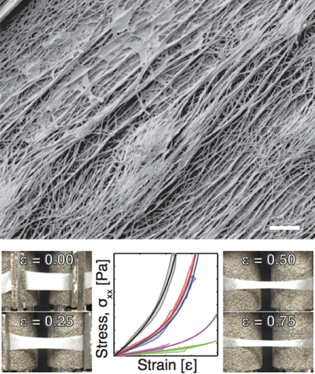
Upon activation, platelets expel polyphosphates into the extracellular space and their high negative charge induces coagulation via factor XII. The biochemical mechanisms by which polyphosphates and NETs promote clotting have been identified in recent studies; however there is little data on how these polymers affect the mechanics of clots.
Understanding Polymer Growth Mechanism by Computational Means (Vyas)
Computational chemistry is a major resource in many facets of chemistry. The use of chemical computations can help guide future work, confirm or deny experimental results, or be used to gain a more descriptive understanding of what may be occurring in a particular system. This project will be focused on the student learning computational tools and utilizing it to study the mechanism of polymer growth. More specifically, the mechanism of interest is substituent effect on chain growth polycondensation (SECGP) for the preparation of polymer brushes.
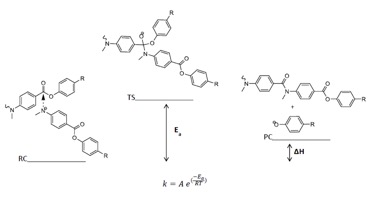
Preliminary calculations have been performed to determine how the mechanism is altered by modifying the leaving group of the reaction. The student will continue and expand the investigation to develop an understanding of various factors such as charge distribution and how they modulate the thermodynamic and kinetic barriers of the mechanism. The results of this computational investigation will be compared to experimental results determined from the Boyes research group.
Assembly of Anisotropic Polymer Particles Under Electric Fields (N Wu)
Although numerous theoretical reports have shown that periodic structures of colloidal particles, arranged with well-controlled configuration and lattice symmetry, can exhibit unprecedented optical properties, the practical implementation is challenging. Our current knowledge of isotropic colloidal systems cannot be simply extended for building those structures of exquisite complexity because of our very limited control over colloidal interactions. To address this challenge, we will create, tune, and exploit a variety of anisotropic interactions by combining rational design in colloidal properties and appropriate application of external electric fields. Our primary objective is to elucidate the fundamental links between various types of microscopically anisotropic interactions and mesoscopically assembled phases, via a complementary experimental and theoretical approach. The REU student will be involved in synthesizing and assembling polystyrene colloidal dimers with combined geometric and surface charge anisotropy.
Fluorescent Nanosensors for the Detection of Ethanol (Cash)
Current measurement techniques are extremely sensitive and specific - but they are often limited in application due to size or the need for offline monitoring. Polymeric nanosensors overcome both of these disadvantages. Their small size enables placement in difficult to measure locations (e.g. inside cells or in the skin), something not possible with typical analytical techniques. They are measured using fluorescence, a technique that can be accomplished with simple imaging components like those found in most smartphones, rather than complicated analytical devices. This project will use our nanosensor platform to detect and quantify oxygen using conjugated polymers and triplet-triplet annihilation (TTA) upconversion. TTA upconversion is an optical process where low energy light excites the nanosensors and they emit high energy light. The REU student will gain experience with polymeric nanoparticle fabrication, characterization techniques, and a range of nanosensor applications.
Anion Transport in Polymer Membranes for Fuel Cells Applications (Herring)
Electrochemical energy conversion (fuel cells, electrolyzes, redox flow batteries exec) in basic media is much more facile than in acidic media. It has recently been recognized that anion exchange membranes (AEMs) can greatly facilitate these processes. With the rapid increase in materials being synthesized for these applications, there is an increasing need to study anion transport in these unique materials, as the assumption that they will work like proton exchange membranes is somewhat invalid as both the polymeric charge carriers are more bulky and hydrophobic and the anions have different and variable solvation as compared to protons. The REU student will work on studying one particular anion, e.g. bromide, in an AEM developed by one of our synthetic partners.
Membrane Modification to Reduce Protein Biofouling (Williams, Boyes)
The flow field-flow fractionation (FlFFF) technique has enjoyed tremendous growth in recent years particularly in the area of protein separations. However, the membrane at the heart of this analysis technique is also the Achilles heel because of undesirable interactions with proteins. This problem must be resolved if FlFFF is to become widely adopted among pharmaceutical and biotechnology companies and regulatory federal agencies. Direct modification of a membrane surface by stimuli responsive polymer brushes is one of the approaches to reducing membrane fouling. By introducing a stimuli responsive polymer on the surface of the membrane, unique control over the properties of the surface can be achieved.
In this project, the REU researcher will be part of a team working on synthesis and characterization of temperature-responsive polymer brushes and membranes and testing modified membrane performance in a FlFFF system in the Williams and Boyes labs.
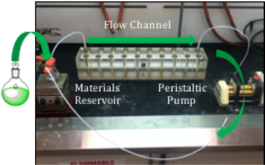
Injectable Biomaterial Delivery Systems (Krebs)
Every year, thousands of children across the United States are plagued with serious problems resulting from growth plate injuries. Current surgical procedures to treat growth plate injuries are invasive, prone to infections, and have low success rates. Thus, the need for a technology that can address growth plate injuries is overwhelming. The field of tissue engineering seeks to regenerate diseased or damaged tissues by providing the necessary physical, biochemical, and cellular cues that promote tissue regeneration.
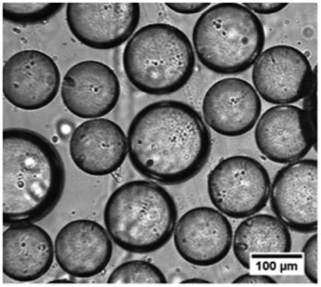
The objective of the proposed work is to investigate an injectable biomaterial delivery system that will deliver factors and provide an environment that helps repair an injured growth plate. Natural biopolymers are being researched for medical applications due to their excellent biocompatibility and unique properties. This project will focus on characterizing the drug release, mechanical properties, and cartilage-forming potential of a biopolymer hydrogel system with embedded biopolymer microspheres.
New Synthetic Methods for Advanced Polymer Brushes (Boyes)
The modification of surfaces with polymers is a field that has fascinated chemists and engineers for over half a century due to the unique ability of polymers to control interfacial properties. Indeed, surface modification using polymers has been directly responsible for both the expansion and improvement of existing technologies and the development of new technologies.Of the many different surface modification techniques available, polymer brushes have received considerable attention and they have been used in applications ranging from sensors to smart coatings.recently researchers have established a need to develop polymer brushes based on aromatic polymers for application in areas such as tribological coatings, reverse osmosis (RO) membranes, and biosensing. This project will expand on exciting preliminary work from the Boyes group and conduct a detailed study into the use of substituent effect chain growth polycondensation (SECGP) for the preparation of aromatic polyamide brushes in order to develop a thorough understanding of the factors influencing brush growth, structure, and functionality, in addition to demonstrating the application of these systems in membranes for RO.
